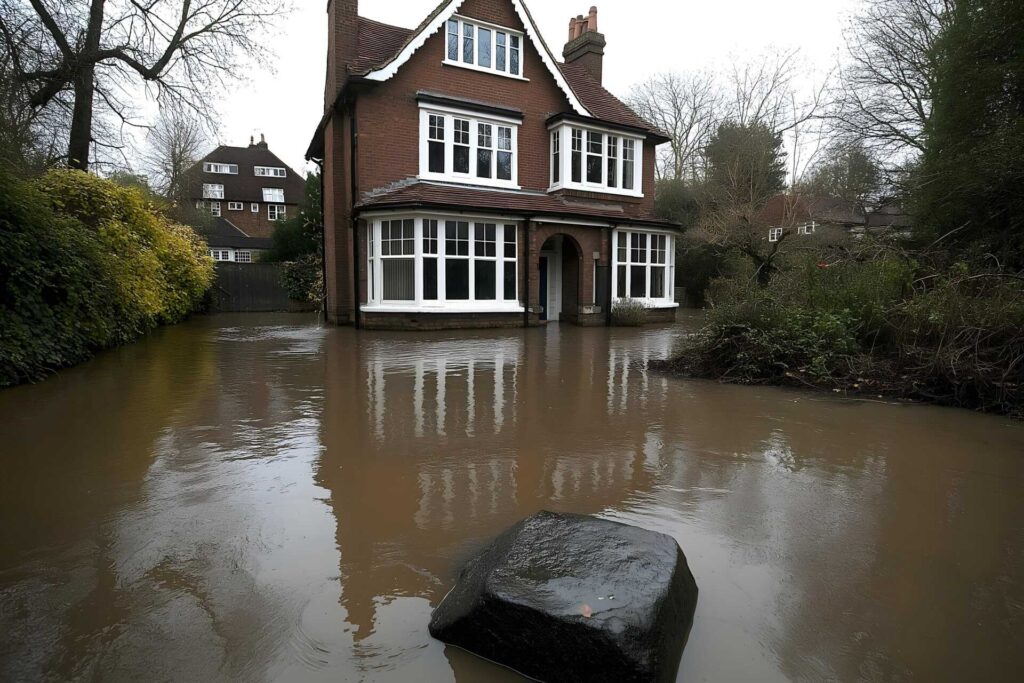
Contents
After a flood, knowing how to act quickly can make a big difference. You need to assess the situation and prioritize safety before tackling the cleanup. It’s vital to have the right equipment on hand to remove water effectively. But what are the best strategies to ensure your home recovers fully? Let’s explore essential tips to guide you through the post-flood water removal process.
Key Takeaways
- Ensure safety by turning off the power and wearing protective gear before starting the water removal process.
- Use a submersible pump for large amounts of standing water and a wet/dry vacuum for smaller areas.
- Prioritize water removal in areas with the most accumulation to prevent further damage.
- Enhance drying by opening windows, using fans, and employing dehumidifiers to control moisture.
- Document all damage thoroughly for insurance claims and seek professional help if needed.
Assess the Situation Immediately
As you step into your flooded space, it’s vital to assess the situation immediately.
First, take a moment to evaluate the flood impact. Look around for standing water, damaged furniture, and affected appliances. Note any structural issues, like cracks in the walls or ceilings. Your goal is to gather information for an accurate damage assessment.
Next, prioritize areas that need urgent attention. Document the extent of the water damage by taking photos and writing down your observations. This will be important for insurance claims later.
If there’s significant standing water, consider how deep it is and whether it poses any hazards.
Ensure Safety First
Before you start removing floodwater, make sure to assess any electrical hazards in your home.
Turn off the power at the circuit breaker to avoid accidents, and wear protective gear like gloves and boots to keep yourself safe.
Your safety is the top priority as you begin the cleanup process.
Assess Electrical Hazards
When floodwaters recede, it’s essential to assess electrical hazards to ensure your safety.
Start by identifying any visible damage to electrical outlets, cords, and appliances. Never assume they’re safe; water can compromise their integrity.
If you see any signs of water damage, turn off the electricity at the main breaker before entering the area. This is critical for electrical safety.
Always assume that any electrical appliance exposed to water is a potential hazard until it’s inspected by a professional.
If you’re uncertain about the condition of your electrical system, contact an electrician for a thorough evaluation.
Prioritizing hazard identification now can prevent serious injuries or worse in the future.
Stay cautious and protect yourself during this challenging time.
Wear Protective Gear
To ensure your safety while dealing with post-flood cleanup, wearing protective gear is a must. Floodwaters can carry harmful contaminants, so equip yourself properly. Here’s a handy table to help you choose the right protective clothing:
| Item | Purpose | Gear Maintenance |
|---|---|---|
| Waterproof Boots | Protects feet from debris | Clean and dry after use |
| Gloves | Shields hands from chemicals | Inspect for holes before use |
| Face Mask | Prevents inhalation | Replace if damaged or dirty |
| Safety Goggles | Protects eyes from splashes | Wipe lenses clean after use |
| Coveralls | Full-body protection | Wash regularly to maintain safety |
Gather Necessary Equipment
Before you start removing water, it’s vital to gather the right equipment.
You’ll need a checklist of essential tools, safety gear, and effective water extraction equipment to make the process smoother and safer.
Let’s go over what you should have on hand to tackle this challenge effectively.
Essential Tools Checklist
As you prepare to tackle the challenging task of water removal after a flood, having the right tools at your disposal can make all the difference. Here’s a quick checklist of essential items and priority tools you’ll need to get started:
| Tool | Purpose |
|---|---|
| Submersible Pump | Removes standing water quickly |
| Wet/Dry Vacuum | Cleans up smaller areas effectively |
| Squeegee | Helps push out remaining water |
| Mop and Buckets | For final drying and cleanup |
| Towels | Absorb moisture in hard-to-reach spots |
With these tools, you’ll be well-equipped to handle the water removal process efficiently. Don’t hesitate to gather these essentials before diving in!
Safety Gear Requirements
Once you’ve gathered your tools for water removal, don’t overlook the importance of safety gear.
Wearing the right equipment can protect you from hazards lurking in flood-affected areas. Start with proper footwear—waterproof boots will keep your feet dry and shield you from sharp debris.
In addition, slip-resistant soles can prevent falls on wet surfaces. Don’t forget protective eyewear; floodwaters may contain harmful contaminants, and goggles will safeguard your eyes from splashes and debris.
It’s also wise to wear gloves to prevent skin contact with pollutants. By prioritizing your safety gear, you’ll be better equipped to tackle the challenges of post-flood cleanup.
Water Extraction Equipment
When tackling post-flood water removal, having the right equipment can make all the difference. Start with a powerful water extraction machine, like a submersible pump or a wet/dry vacuum. These tools will help you remove standing water quickly and efficiently.
Don’t forget about fans and dehumidifiers, as they’re essential for drying out the affected area and preventing mold growth.
Before diving in, verify your equipment is in good working condition. Regular equipment maintenance can save you time and headaches later on.
Check hoses for leaks, clean filters, and inspect electrical connections. By being prepared with the right tools and maintaining them well, you’ll tackle the aftermath of flooding more effectively and help restore your space faster.
Start Water Removal Process
Begin the water removal process as soon as it’s safe to do so. Time is vital in preventing further damage, so act quickly.
Start by evaluating the area for hazards like electrical wires or unstable structures. Once it’s safe, choose effective water removal techniques. Use a submersible pump for large amounts of standing water and wet vacuums for smaller areas.
If you have access to a generator, it can power your equipment without relying on the grid. Implement flood cleanup strategies by prioritizing areas with the most water accumulation first. Work systematically to ensure no spots are overlooked.
Don’t forget to wear protective gear, including gloves and boots, to safeguard yourself from contaminants.
Dry Out Affected Areas
As you work to dry out affected areas, it’s essential to act quickly to prevent mold growth and structural damage. Start by opening windows and doors to enhance air circulation. Use fans and dehumidifiers for effective moisture control.
| Affected Area | Action Needed | Emotional Impact |
|---|---|---|
| Walls | Wipe down and ventilate | Relief from worry |
| Carpets | Remove and dry thoroughly | Hope for restoration |
| Furniture | Elevate and dry with fans | Comfort in recovery |
| Personal Items | Sort, dry, and keep safe | Reassurance in memories |
Stay vigilant in your efforts, as prolonged moisture can lead to more serious issues. By taking these steps, you’re not just drying out your space; you’re protecting your home and peace of mind.
Disinfect and Sanitize Surfaces
Once you’ve dried out the affected areas, the next step is to disinfect and sanitize surfaces to eliminate any lingering bacteria or contaminants.
Use effective cleaning solutions like a mixture of water and bleach or commercial disinfectants specifically designed for post-flood situations. Always read the labels to verify they’re appropriate for the materials you’re treating.
Start with high-touch areas like doorknobs and countertops, applying your chosen cleaning solution generously. Allow it to sit for the recommended time to effectively kill germs.
For porous surfaces, consider using a dedicated surface treatment that penetrates deeper to ensure thorough sanitation.
Remember to wear gloves and a mask to protect yourself from harsh chemicals.
Once you’ve treated all surfaces, rinse them with clean water if required. This process helps restore safety and hygiene to your home, giving you peace of mind after the flood.
Seek Professional Help if Needed
When you’re overwhelmed by the aftermath of a flood, knowing when to seek professional help can make a significant difference.
If you’re struggling with extensive water damage, mold growth, or structural issues, don’t hesitate to reach out to experts. They’ve the tools and knowledge to assess the situation and provide effective solutions.
You might also need assistance with insurance claims. Professionals can guide you through the process, ensuring you document the damage properly and maximize your coverage. This support can alleviate some stress as you navigate recovery.
Don’t forget to tap into local resources. Many communities offer services for flood recovery, including cleanup crews and mental health support.
These resources can help you feel less isolated and more equipped to tackle the challenges ahead. Remember, asking for help isn’t a sign of weakness; it’s a smart step towards restoring your home and peace of mind.
Wrap-Up
In the aftermath of a flood, taking swift action is essential to prevent further damage. By prioritizing safety, removing water promptly, and drying out your space, you can save your home from becoming a soggy disaster zone. Don’t hesitate to reach out for professional help if the situation feels overwhelming; their expertise can be a lifesaver. Remember, with the right approach, you can restore your home and peace of mind faster than a superhero can change costumes!
Recent Posts
Master Flood Recovery: Test Your Water Removal Skills
Many people underestimate the complexity of flood recovery, often thinking it’s just about removing water.
Why Is Emergency Water Removal Crucial After Flooding?
When flooding occurs, emergency water removal is vital to mitigate serious health risks and property
10 Best Tips for Emergency Water Removal After Flooding
You might think that dealing with flooding is overwhelming, but taking swift action can greatly
